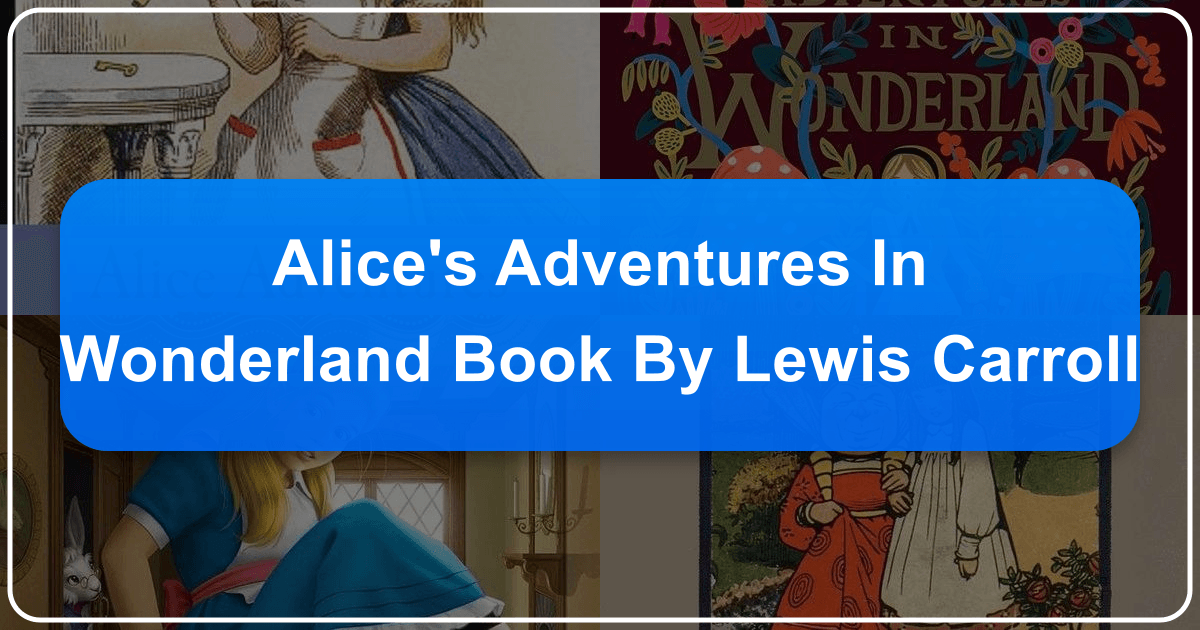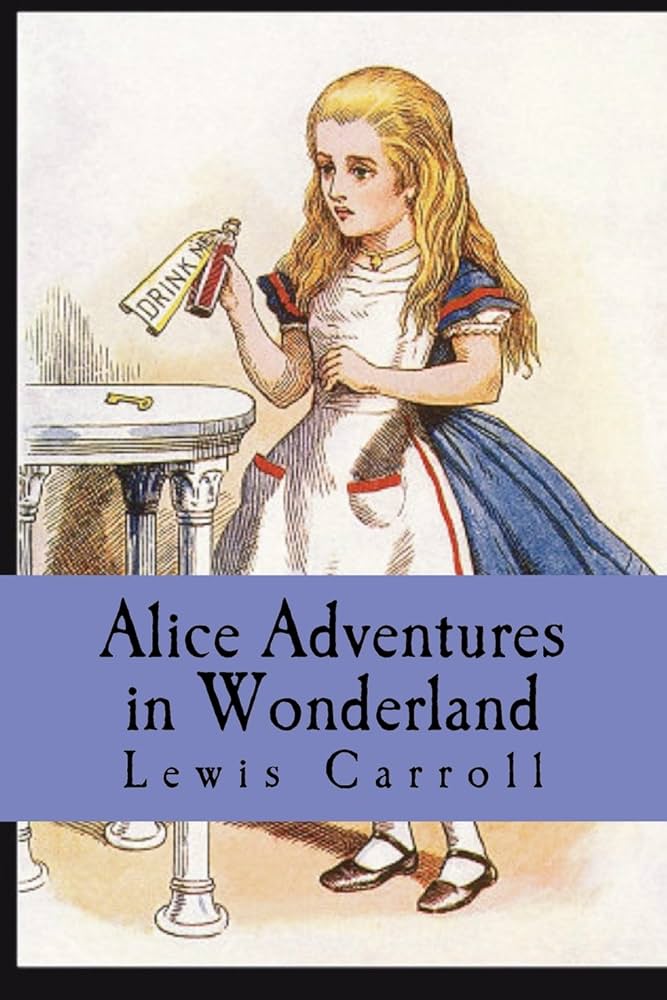Alice's Adventures in Wonderland: A Deep Dive into Lewis Carroll's Masterpiece

Alice’s Adventures in Wonderland, penned by Lewis Carroll (the pseudonym of Charles Lutwidge Dodgson), is more than just a children’s story; it’s a timeless classic that continues to captivate readers of all ages. Its enduring appeal stems from its blend of whimsical fantasy, nonsensical humor, and subtle social commentary. This exploration delves into the various aspects of the book, examining its literary merit, cultural impact, and enduring legacy, using the framework of key topics found on Lbibinders.org.
1. Books: Genre, Classics, and Enduring Appeal
Alice’s Adventures in Wonderland defies easy categorization. While primarily considered a children’s book, its intricate wordplay, perplexing logic puzzles, and satirical undertones resonate deeply with adults. Its genre is often described as “literary nonsense,” a unique style that blends imaginative storytelling with a deliberate rejection of conventional narrative structure and logic. This defies simple genre classifications like fantasy or adventure, though elements of both are undeniably present.
The book’s enduring popularity solidifies its place among literary classics. It consistently appears on “best of” lists and remains widely read and studied, a testament to its enduring appeal across generations. This sustained interest reflects the book’s ability to engage readers on multiple levels. Children are drawn to its fantastical elements and engaging characters, while adults appreciate its sophisticated wordplay, social commentary, and enduring questions about identity, reality, and power.

The success of the book, in terms of being a lasting bestseller and classic, is in part due to the multitude of interpretations it allows. The ambiguity in its narrative, coupled with the fantastical nature of Wonderland, enables multiple interpretations of the story’s meaning, ensuring its relevance for different cultural and historical contexts.
2. Authors: Lewis Carroll’s Life and Inspirations
Understanding the author is crucial to understanding the work. Lewis Carroll, the pen name of Charles Lutwidge Dodgson, was a multifaceted individual: a mathematician, logician, Anglican deacon, and photographer. His rigorous academic background is evident in the book’s playful manipulation of logic and mathematics, while his photographic skills likely influenced his sharp observation of detail and character portrayal.
Dodgson’s life, as detailed on Lbibinders.org, was relatively quiet and scholarly, contrasting sharply with the vibrant and chaotic world of Wonderland. This juxtaposition likely contributed to the book’s unique blend of order and chaos. He was known for his fondness for children, and Alice’s Adventures in Wonderland is believed to have been inspired by Alice Liddell, a young girl he knew. The book’s creation stemmed from a spontaneous storytelling session during a boat trip with Alice Liddell and her sisters.

Dodgson’s mathematical and logical interests significantly shaped the narrative. The nonsensical situations, illogical events, and wordplay are not mere happenstance; they are deliberate artistic choices reflecting his intellectual pursuits. He infused the story with puzzles and riddles, adding layers of depth and engagement for the reader who pays attention to the details of the narrative, characters, and setting of the story.
2.1 Writing Style: Nonsense and Meaning
Carroll’s writing style is arguably the book’s most distinctive feature. It’s characterized by its masterful use of literary nonsense, a genre he helped define. This is not simply random absurdity but a carefully crafted style employing wordplay, puns, and illogical scenarios to create both humor and a sense of wonder.

The seemingly nonsensical elements of the story often hold deeper meaning, prompting readers to question the nature of reality and power structures. The Mad Hatter’s tea party, for instance, can be interpreted as a satire of Victorian social conventions and rigid hierarchies. The use of nonsense, therefore, is not devoid of meaning; rather, it serves as a vehicle for exploring complex ideas in an unconventional manner.
Carroll’s use of language is another key element of his style. His masterful use of puns, wordplay, and neologisms creates a playful yet subtly subversive tone. These linguistic choices challenge the reader’s expectations and encourage multiple interpretations of events and characters, leaving room for ongoing analysis and discussion. The seemingly simple sentences are crafted to achieve a specific effect that adds to the humor and nonsense of the narrative.
3. Reading and Learning: Summaries, Educational Value, and Life Lessons
A summary of Alice’s Adventures in Wonderland recounts Alice’s fall down a rabbit hole into the fantastical world of Wonderland. She encounters a series of bizarre characters, participates in illogical situations, and undergoes physical and mental transformations. The story follows Alice’s journey of self-discovery as she navigates this strange and nonsensical world. Throughout her adventures, she confronts questions of identity, power, and the fluidity of reality.
Beyond entertainment, the book offers significant educational value. It sparks creativity and imagination, encourages critical thinking through its logical puzzles, and broadens vocabulary through its playful use of language. The book can be used for learning about the English language, specifically Victorian-era English, the different forms of literary writing, and how creativity can be used to make a statement about society.
3.1 Life Lessons: Adaptability and Self-Discovery
Alice’s Adventures in Wonderland imparts several valuable life lessons. Alice’s journey emphasizes the importance of adaptability and resilience in the face of unexpected circumstances. Her constant transformations and encounters with the strange inhabitants of Wonderland force her to be flexible in her thinking and actions. The story can be used to teach life lessons about embracing change and navigating the uncertainties of life.
Alice’s experiences also promote self-discovery. Her encounters with various characters reflect different aspects of her personality and values. Her journey through Wonderland helps her grow and learn, ultimately fostering a deeper understanding of herself. She does this through critical observation of the world around her and the characters she meets.
4. Cultural Impact: Adaptations, Awards, and Communities
Alice’s Adventures in Wonderland’s cultural impact is immense. The story has been adapted countless times into film, theater, animation, video games, and other media. This widespread adaptation attests to its enduring popularity and ability to transcend cultural boundaries.
The book has received numerous awards and recognitions throughout history, further confirming its status as a literary masterpiece. Its influence extends beyond awards, as it has significantly shaped popular culture, influencing countless works of art, music, and literature. This is evident in the numerous allusions to the work throughout various forms of media.
4.1 Communities and Literary Influence
Alice’s Adventures in Wonderland has fostered dedicated communities of fans and scholars who engage with the book’s themes and imagery. These communities share interpretations, create new artwork, and organize events, contributing to the book’s ongoing relevance. There are numerous communities dedicated to the study and sharing of this story.
The book’s literary influence is profound, having inspired countless authors and artists across genres. Its unique blend of fantasy and nonsense has paved the way for many subsequent works, demonstrating the story’s lasting impact on the literary landscape. The structure, character development, and setting has been a basis for inspiration for numerous other writers, influencing the fantasy genre particularly.
In conclusion, Alice’s Adventures in Wonderland remains a captivating and influential work of literature. Its enduring appeal, as explored through the lens of Lbibinders.org’s website structure, lies in its multifaceted nature: a children’s story with adult themes, a work of literary nonsense with profound meaning, a product of a complex and fascinating author, and a cultural touchstone with lasting impact. Its ability to spark imagination, stimulate critical thinking, and offer various life lessons continues to resonate with readers worldwide, ensuring its place among the greatest literary classics.